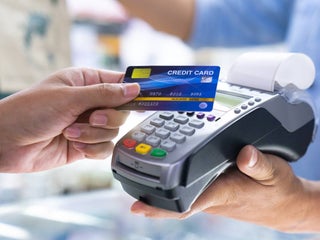Summary
Credit card cash advances are much more expensive than typical credit card purchases, according to a recent CreditCards.com examination of 100 popular cards.
The content on this page is accurate as of the posting date; however, some of our partner offers may have expired. Please review our list of best credit cards, or use our CardMatch™ tool to find cards matched to your needs.
Credit card cash advances are much more expensive than typical credit card purchases, according to a recent CreditCards.com examination of 100 popular cards.
The average cash advance APR is 24.80%. Most top credit cards only offer one cash advance rate, irrespective of the cardholder’s credit score. Some offer a range depending on the customer’s creditworthiness. In that case, we averaged the high and the low.
For regular purchases, most of those cards charge a range of interest rates that vary according to the cardholder’s credit profile. Using the same methodology of averaging the high and the low for each card, and then averaging the rates charged by all 100 cards, we ended up with 19.84%. That’s an apples-to-apples comparison to the 24.80% listed above for cash advances.
Cash advances sting in two other ways:
- They begin charging interest immediately. On a typical purchase, assuming you paid your previous month’s charges in full, you usually have a grace period of several weeks before interest starts accruing. No such luck on cash advances.
- Almost all cash advances tack on another fee. Ninety-six of the 100 cards we surveyed charge a cash advance fee on top of the high interest rate that begins accruing immediately. This separate cash advance fee is most commonly $10 or 5%, whichever is higher. Only two cards in our sample do not assess a cash advance fee (the PenFed Power Cash Rewards Visa Signature Card and the PenFed Promise Visa Card). Two others do not allow cash advances (The Blue Business® Plus Credit Card from American Express and the Deserve EDU Mastercard for Students).
See related: How to lower your credit card interest rate
5 highest cash advance APRs
- First PREMIER Bank credit card: 36.00%
- BP Visa card: 29.99%
- Techron Advantage Visa card: 29.99%
- ExxonMobil SmartCard: 29.95%
- Meijer Mastercard: 27.99%
5 lowest cash advance APRs
- Navy Federal Credit Union Platinum Card: 14.75%
- Navy Federal Credit Union cashRewards Card: 16.58%
- USAA Rewards Visa Signature card: 17.90%
- PenFed Power Cash Rewards Visa Signature Card: 17.99%
- PenFed Promise Visa: 17.99%
What is a credit card cash advance?
When most people think of a cash advance, they probably think of using their credit card to obtain cash from an ATM. This is a common example, but it’s far from the only possibility. Others include the paper cash advance convenience checks provided by your card issuer and using your credit card for gambling, bail bonds and cash-like transactions such as wire transfers, traveler’s checks and money orders.
How much does a cash advance cost?
Let’s say you take out a $1,000 cash advance and aim to pay it off in 30 days. If your card charges the typical 5% cash advance fee, that’s $50. Plus, at the average cash advance APR (24.80%), you’ll owe about $21 in interest. That’s an extra $71 in just one month – and the math is far worse if you carry the balance for longer.
If you only make minimum payments toward that $1,000 cash advance, you’ll be in debt for more than six years and you’ll end up paying a grand total of about $2,000.
Another thing to know about cash advances and minimum payments: Many cards apply your minimum payment to the lowest interest rate first. If your balance includes a mix of purchases and cash advances and you’re only paying the minimum, it’s going to be even harder to knock down that high-interest cash advance balance. Payments above the minimum must be applied to the highest interest rate first.
Is there a limit to how much cash you can get?
Chances are your cash advance limit is significantly lower than your overall credit limit. To protect themselves (and cardholders, to some extent), card issuers usually cap your cash advance limit between 10% and 40% of your total credit limit. Also, you’re unlikely to earn rewards on cash advance transactions.
See related: How credit scores affect interest rates
Cash advance alternatives
Cash advances aren’t as expensive or risky as payday loans and car title loans, but they should be among your last resorts.
Ask your card issuer for help
If you’re just looking for short-term relief, the best option is to ask your credit card issuer for a break. They have hardship programs that can rearrange due dates, raise your credit limit and waive interest and other fees, all while protecting your credit score from negative impacts. These programs are especially popular among people who have lost their jobs or been victimized by natural disasters.
Personal loan
Personal loans can be a solid option as well. In many cases, you can get cash within 24 hours, along with an interest rate in the mid-to-high single digits (if you have a good credit score). Borrowers with lesser credit pay much higher rates, if they’re approved at all. Note that lending standards have tightened considerably of late due to the economic disruption caused by the COVID-19 pandemic.
Balance transfer or 0% introductory APR card
Signing up for a 0% balance transfer card or a 0% introductory APR card is a cheaper option, although these represent credit, not actual cash. And they, too, have become harder to obtain in recent weeks. With today’s strict underwriting standards, rather than opening a new card, it’s worth checking to see if you already have a card that qualifies.
For example, my Wells Fargo Propel American Express® card is offering me a 0% balance transfer for 15 months (there’s a 4% transfer fee, $5 minimum and the regular APR after the term expires is 15.49%). This is a really good deal – it’s actually three months longer than the standard offer for new cardholders.
Credit card payment plan
You could also pursue a hybrid credit card/personal loan approach on one of your existing cards. American Express, Chase and Citi offer payment plans that piggyback off existing credit lines but charge lower interest rates and more clearly define the payoff period.
Borrow from a family member or friend
Then there’s the Bank of Mom and Dad (or a different friend or family member). Financially, this option is much less likely to incur interest or hurt your credit score. But it can lead to hurt feelings, so tread carefully from a relationship perspective.
Borrow from yourself
If you have a Roth IRA, you can withdraw your contributions (although not earnings) without paying taxes or penalties. The primary downside is losing the potential for future investment gains, especially if you’re selling when the market is down.
You could also consider a 401(k) loan or a home equity line of credit (HELOC). Expect mid-single-digit rates on both. With a 401(k) loan, if you leave your job, you’ll have to pay the loan back very quickly or face stiff tax penalties. The main risk of a HELOC is that you’re putting your home on the line if you’re unable to repay the loan.
See related: What is a good APR for a credit card?
Bottom line
Even if your situation seems dire, it’s important to know that you have several options, and a cash advance probably isn’t your best bet.
Methodology: CreditCards.com reviewed the terms and conditions for 100 popular credit cards on April 15, 2020. The 100-card survey pool is the same group of cards we use to calculate our Weekly Rate Report. It is a representative sampling of cards from all major U.S. card issuers.
Editorial Disclaimer
The editorial content on this page is based solely on the objective assessment of our writers and is not driven by advertising dollars. It has not been provided or commissioned by the credit card issuers. However, we may receive compensation when you click on links to products from our partners.



